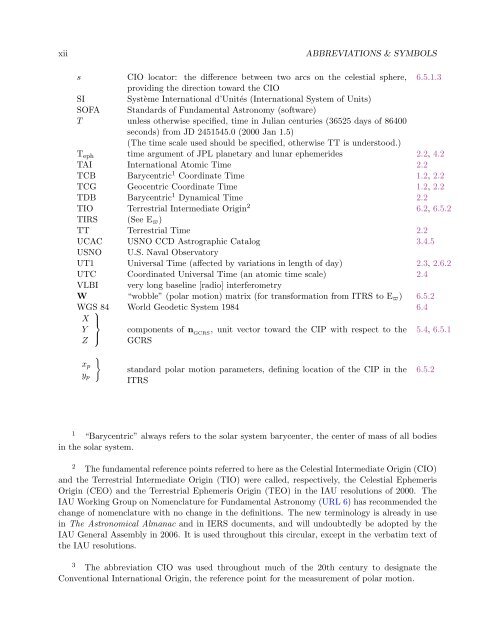USNO Circular 179 - U.S. Naval Observatory
USNO Circular 179 - U.S. Naval Observatory
USNO Circular 179 - U.S. Naval Observatory
Create successful ePaper yourself
Turn your PDF publications into a flip-book with our unique Google optimized e-Paper software.
xii ABBREVIATIONS & SYMBOLS<br />
s CIO locator: the difference between two arcs on the celestial sphere,<br />
providing the direction toward the CIO<br />
6.5.1.3<br />
SI Système International d’Unités (International System of Units)<br />
SOFA Standards of Fundamental Astronomy (software)<br />
T unless otherwise specified, time in Julian centuries (36525 days of 86400<br />
seconds) from JD 2451545.0 (2000 Jan 1.5)<br />
(The time scale used should be specified, otherwise TT is understood.)<br />
Teph time argument of JPL planetary and lunar ephemerides 2.2, 4.2<br />
TAI International Atomic Time 2.2<br />
TCB Barycentric 1 Coordinate Time 1.2, 2.2<br />
TCG Geocentric Coordinate Time 1.2, 2.2<br />
TDB Barycentric 1 Dynamical Time 2.2<br />
TIO Terrestrial Intermediate Origin 2 6.2, 6.5.2<br />
TIRS (See Eϖ)<br />
TT Terrestrial Time 2.2<br />
UCAC <strong>USNO</strong> CCD Astrographic Catalog 3.4.5<br />
<strong>USNO</strong> U.S. <strong>Naval</strong> <strong>Observatory</strong><br />
UT1 Universal Time (affected by variations in length of day) 2.3, 2.6.2<br />
UTC Coordinated Universal Time (an atomic time scale) 2.4<br />
VLBI very long baseline [radio] interferometry<br />
W “wobble” (polar motion) matrix (for transformation from ITRS to Eϖ) 6.5.2<br />
WGS⎫ 84<br />
X ⎪⎬<br />
World Geodetic System 1984 6.4<br />
Y<br />
Z<br />
⎪⎭<br />
components of nGCRS , unit vector toward the CIP with respect to the<br />
GCRS<br />
5.4, 6.5.1<br />
xp<br />
yp<br />
<br />
standard polar motion parameters, defining location of the CIP in the<br />
ITRS<br />
1 “Barycentric” always refers to the solar system barycenter, the center of mass of all bodies<br />
in the solar system.<br />
2 The fundamental reference points referred to here as the Celestial Intermediate Origin (CIO)<br />
and the Terrestrial Intermediate Origin (TIO) were called, respectively, the Celestial Ephemeris<br />
Origin (CEO) and the Terrestrial Ephemeris Origin (TEO) in the IAU resolutions of 2000. The<br />
IAU Working Group on Nomenclature for Fundamental Astronomy (URL 6) has recommended the<br />
change of nomenclature with no change in the definitions. The new terminology is already in use<br />
in The Astronomical Almanac and in IERS documents, and will undoubtedly be adopted by the<br />
IAU General Assembly in 2006. It is used throughout this circular, except in the verbatim text of<br />
the IAU resolutions.<br />
3 The abbreviation CIO was used throughout much of the 20th century to designate the<br />
Conventional International Origin, the reference point for the measurement of polar motion.<br />
6.5.2


